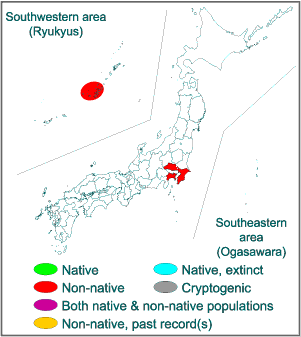
 Japanese |
English
Japanese |
English- Invasive Species of Japan >
- Aves >
- Acridotheres tristis
| Invasion information | ||
| Range in Japan | There are records of breeding in Saitama, Chiba, and Kanagawa Prefs., and observation in Kumejima, Ishigakijima, and Yonagunijima Is. Since 1990s, no breeding have been observed. There is a report of sighting at Kumamoto pref in 2019. |

|
| Origin | Unknown. | |
| Date | Observed in 1961 to 1981 in Kanto District. | |
| Route | Deliberate: Escape or release of pet animal. | |
| Impact | Potentially: Killing eggs of native birds, competition for breeding site with native birds, and damage on agriculture are observed in foreign country. Native organism(s) affected: Native birds. | |
| Regulation in Japan | No action for prevention, mitigation, control, or eradication. | |
| Introduced range in other countries | Borneo, Sumatra, Israel, Lebanon, Turkey, Iraq, UAE, South Africa, Botswana, Zimbabwe, Australia, New Zealand, Papua New Guinea, USA (Florida), Bahama, Cuba, Jamaica, Puerto Rico, Hawaii, Midway, Solomon, New Caledonia, Vanuatu, French Polynesia, Madagascar, Reunion, Mauritius, Comoros, etc. | |
| Reference | Notes |
|
100 of the World’s Worst Invasive Alien Species |